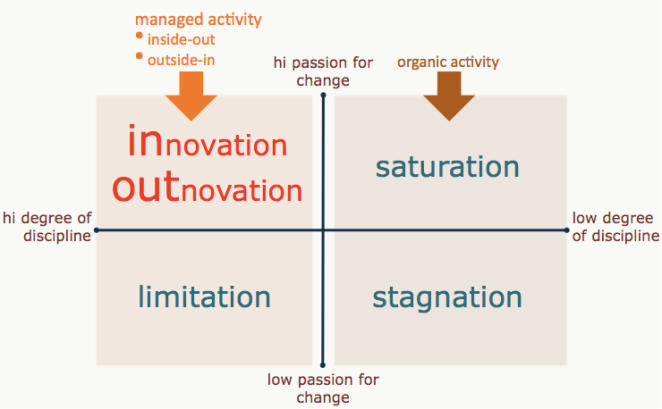
While even I, a self-professed “innovationeer”, have tired of the ubiquity and repetition of the word “innovation” in advertising, marketing plans, brainstorms, boardrooms and blogs, I better get over it; it’s not likely to go out of fashion any time soon. Consumers crave better usability, functionality and experiences, fueled by innovative design, technology, interfaces and business models. Economists are banking on it!
So, while prepping for my appearance on FOX TV’s “Fox and Friends” morning show on July 27th (where I’ll be discussing my entrepreneurship innovation and inventions), I was pondering: what’s the opposite of innovation?
micro-trend: UNnovation
I know that with every mega trend there’s always a counter-trend. While the pendulum of culture swings towards “INnovation”, another pendulum must be swinging in the opposite direction representing the counter-culture trend of “UNnovation”. I imagine “UNnovation” is the resistance to change and a celebration of stasis, tradition and things deemed classic and evergreen (think: Coke’s current secret ingredient campaign). This is parodied by the Shredded Wheat ad campaign “Putting the No into Innovation” (watch this video).
macro-trend: OUTnovation
But we culture cartographers like to examine the topography (the dimensions) of a concept from different angles. So if we map the innovation world (see above) we stumble upon:
- stagnation – can happen when there’s too little effort or guidance.
- limitation – can happen when there’s too much control on a half-hearted innovation process.
- saturation – can happen when there too little control on an aggressive innovation effort.
Then my mind wandered to what happens when there’s: discipline + passion for change? It occurred to me that there are two ways to manage innovation. From the inside-out (the classic approach) and from the outside-in, or “OUTnovation”. OUTnovation is OUT-sourced innovation, new product development, creativity and design. It’s when companies seek and aggregate inputs from an “insight collective” outside of the company. If innovation as we know it today started with the suggestion box, then think of OUTnovation as a suggestion community cultivated to think outside of the box.
analogs
Here are three very different manifestations of OUTnovation in practice to illustrate this trend:
- TrendWatching.com – Recently I became an “official” trend-spotter for the global TrendWatching report, which means I’m now part of an international network of 170 culture cartographers who are out-sourced trend-spotters. I access a private webpage to get briefs from the folks at TrendWatching requesting me to ponder an insight, explore the nodes of a trend or seek examples to illustrate a trend. I then post my work and earn cash or points to buy cool items (just like a credit card).
- CampbellSoupCompany.com/ideas – Campbell’s Soup’s new website taps scientists, entrepreneurs and inventors outside of the company to generate new ideas for new products and packaging, technologies, marketing and business processes. Unlike TrendWatching which issues a tight creative brief to steer innovation, the Campbell’s Soup company is open to ANY idea. It’s an on-going open-call for innovation. The company evaluates all submissions and the owners of winning ideas that the company decides to explore are then compensated.
- OpenAd.net – OpenAd is another website that is a global online marketplace for great advertising, marketing and design ideas. It’s kind of like Match.com for innovation. The site boasts 11,500 members in 125 countries comprised of both clients and innovators. BTW: the clients are MAJOR international brands. Clients post briefs and host pitches via the site, which also contains an ideas gallery where ideas posted, purchased or licensed.
why now?
The IT industry has been practicing OUTnovation for years. In fact, the digital world invented it (think: computer programmers in India). But, historically brand companies have shunned out-sourcing their innovation because they feel it compromises their trade secrets. However, with so much great talent on the streets clients have access to out-sourced innovation (at lower costs). Unemployment and financial pressures have made both clients and inventors less precious about sharing information and intellectual property. Also, with technology we can efficiently communicate with talent who are closer to the markets we want to reach and/or manufacture in.
what if? global currency
As borders blur and services, such as innovation are out-sourced, foreign currency exchange becomes problematic. FOREX fluctuations add unnecessary complexity to assembling international innovation teams. While the IMF is advancing towards introducing a global currency for debt relief, in the meantime we can use gold as an international monetary standard. About a decade ago I was instrumental in setting up a company called GoldMoney.com, which thrives today. It’s a website where clients and innovationeers can pay and be paid in grams of gold which are physically held in a secure, tax-free vault. Payments are instant and have no fees (such as the fees associated with wire transfers and FOREX). I imagine the irony of gold being used as a global standard for paying for ideas and OUTnovation. Goldmoney.com is where the ethereal and substantial could converge.

Hello there, I discovered your website by means of Google at the same time as searching for a similar subject, your site got here up, it appears to be like good. I have bookmarked it in my google bookmarks.